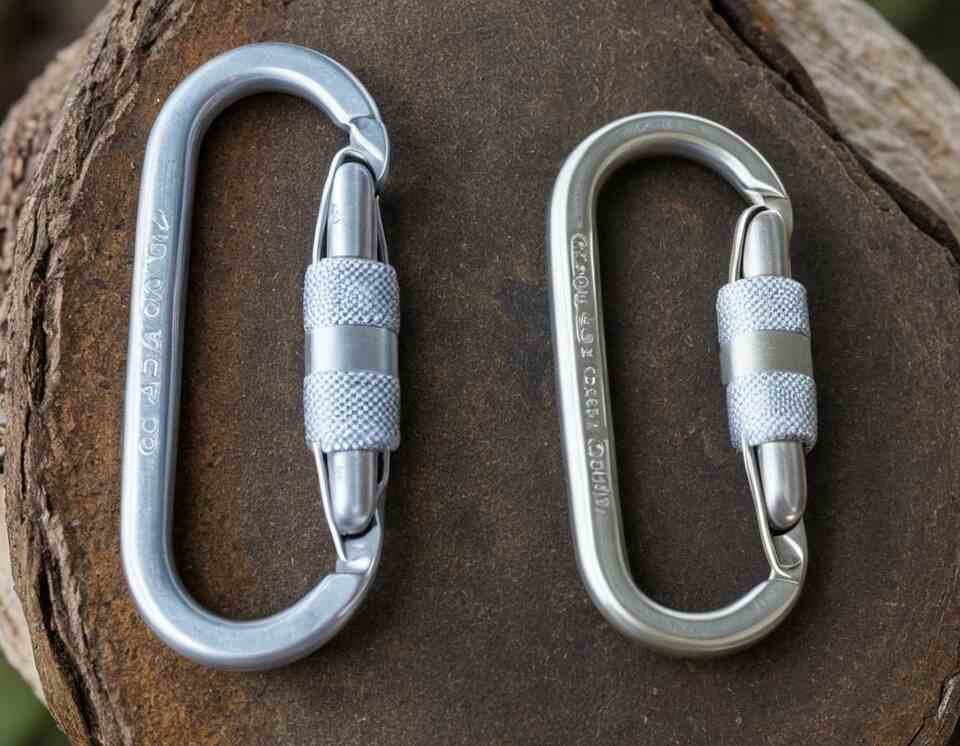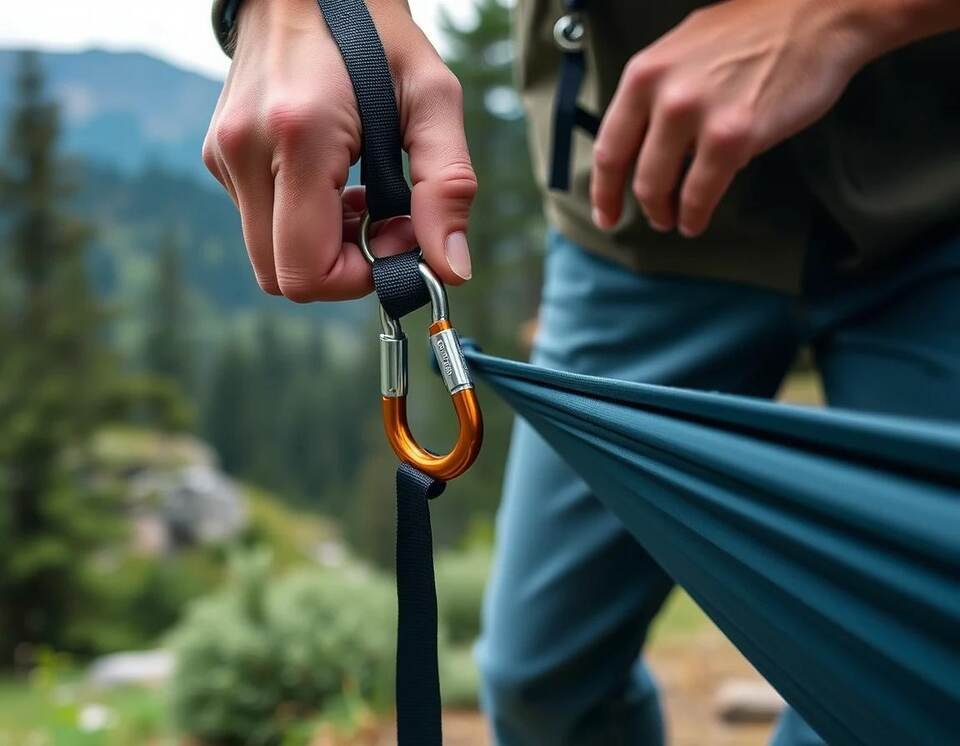Affiliate Disclosure: As an Amazon Associate, I earn from qualifying purchases. This means I may receive a commission if you buy through my links, at no extra cost to you.
When you’re setting up your hammock for a day of lounging in the sun, a hike to your favorite campsite, or even just relaxing in your backyard, the last thing you want to worry about is whether your hammock setup will hold up. But here’s the thing: choosing the right carabiners for your hammock is essential. And no, not all carabiners are created equal!
Whether you’re new to hammocking or a seasoned pro, you might be asking yourself: “What exactly makes a carabiner good for hammocking?” Well, don’t worry. Karenzo Hammocks has got your back!
In this guide, we’ll dive into everything you need to know about choosing the perfect hammock carabiners. From materials and weight ratings to types and best practices, we’ll cover it all to make sure your hammock setup is safe and comfy. So grab a cold drink, get comfy, and let’s get started!
Click the Play button below to listen to our podcast:
Why Do Carabiners Matter for Hammocks?
You might be thinking, “It’s just a carabiner, right? They all do the same thing!” I get it. But trust me, the right carabiner can make a world of difference. A carabiner isn’t just a fancy little clip that holds your hammock up. It plays a huge role in keeping you safe and making sure your hammock is sturdy enough to hold your weight. After all, you do want to enjoy a nice nap or afternoon read without worrying about a surprise fall to the ground, right?
When you’re hammock camping or even just hanging in your backyard, your carabiners need to be strong enough to handle the weight of your body (and maybe even your gear). You wouldn’t want to risk something snapping or failing halfway through your relaxation session, right? Yeah, me neither. So let’s go ahead and make sure we get this part right.
Materials Matter: Choosing the Best for Durability
When it comes to carabiners, the material they’re made of is one of the first things you’ll want to pay attention to. After all, these little clips are going to hold your hammock, and you want them to be tough. Most hammock carabiners are made from one of two materials: aluminum or steel.
Aluminum Carabiners: Light and Strong, But…
Aluminum carabiners are the go-to choice for most hammockers, especially if you plan on doing some backpacking or hiking with your hammock. Why? Because they’re light—like, really light. And when you’re hauling all your gear across a few miles, every ounce counts, right?
They’re also pretty strong for their weight. Most aluminum carabiners can easily support the weight of an average adult and some gear without any problems. But—and here’s a big but—aluminum is a bit less durable than steel. It can get scratched or dinged up more easily, and over time, those small imperfections can weaken the metal. So, if you’re using your hammock in rough conditions (like camping in rugged areas or around sharp rocks), you’ll need to be a little extra cautious.
Steel Carabiners: Heavy Duty for Serious Hammocking
Steel carabiners, on the other hand, are the heavy-duty option. They’re significantly stronger and more durable than aluminum, but they also come with a weight penalty. So if you’re planning on a big camping trip or just want some serious peace of mind, steel is the way to go.
These are great for people who use their hammock in more rugged environments (think mountains, forests, or places with lots of abrasion). Steel carabiners can take a beating, and they’re less likely to get scratched up or deformed over time. However, be prepared for them to add some weight to your setup. Steel carabiners are usually heavier, so if you’re backpacking, they could slow you down a bit.
Which One’s Right for You?
If you’re a casual backyard hammock user or even a light camper, aluminum carabiners will probably do the job just fine. They’re light, reliable, and strong enough for most setups. But if you’re hiking long distances with your hammock or setting it up in tougher conditions, steel carabiners might be worth the extra weight for that added durability.
Weight Capacity: Don’t Cut Corners
Okay, now that we know the materials, let’s talk weight capacity. This is huge. You don’t want to end up hanging from a carabiner that can’t actually support your weight (awkward, right?). Carabiners come in different weight ratings, and this is where you should definitely not skimp. The last thing you want is a mishap just because you didn’t check the weight capacity.
Most hammock carabiners are rated to handle somewhere between 200–500 pounds, but here’s the thing: always go with a carabiner that’s rated higher than your body weight. You want to be sure it’s strong enough for you, plus any extra gear or accessories you might hang from it (think: a pillow, extra blanket, or maybe even a drink while you relax).
Quick Tip: If you’re unsure what your hammock can handle, check the weight rating on the hammock itself. The carabiners you choose should be rated at or above the weight capacity listed on your hammock. (Better safe than sorry, right?)
Types of Carabiners: What Works Best for Your Setup?
So, you’ve got your material and weight sorted. But now, what about the type of carabiner? Yeah, there’s more than one kind. And choosing the right type is just as important as the material and weight. There are a few common types of carabiners you’ll come across when shopping for your hammock setup:
Locking Carabiners: Extra Safety
Locking carabiners are exactly what they sound like—they come with a locking mechanism that prevents the gate from accidentally opening. This adds an extra layer of security, which is great if you’re using your hammock in a more rugged or dynamic environment. The last thing you want is for your hammock to shift around and for the carabiner to pop open. Yikes!
Locking carabiners come in a couple of varieties: screw-lock, twist-lock, and auto-lock. Screw-lock is the most common, where you twist the barrel to lock the gate in place. Twist-lock is even faster—you just twist it to open or close—but it can wear out over time. Auto-locking carabiners are the most high-tech; they automatically lock when closed, which is convenient but often a bit pricier.
Non-Locking Carabiners: Quick and Easy
If you’re just setting up your hammock in a relaxed spot (like your backyard), a non-locking carabiner might be all you need. These are easy to clip on and off, and they’re lighter than locking ones. That said, they don’t offer the same security. So, while they’re great for quick setups in safe environments, you might want to skip them if you’re hanging in a more rugged area (like, say, a windy campsite on a mountain).
Carabiner Shape: Keylock, D-Shaped, and More
Carabiners also come in a few different shapes, and the shape can affect how easy it is to use and how much weight they can hold. The most common shapes are:
- D-Shaped Carabiners: These are the most typical for hammock setups. They’re strong and easy to clip onto straps or trees. They’re shaped like the letter “D,” so they distribute the load evenly, making them a solid option for most people.
- Keylock Carabiners: These carabiners have a smooth gate that doesn’t snag on your gear or straps, which makes them perfect if you’re constantly adjusting your hammock setup. They’re a bit more expensive but worth it if you’re going for convenience.
How to Use Carabiners Properly
Okay, so now you know what to look for in a hammock carabiner, but let’s talk about how to use them. After all, even the best carabiner is only effective if you use it correctly.
1. Attach Properly
Make sure you’re clipping the carabiner through both your hammock straps and the tree strap or other anchor point. This helps distribute the weight evenly. Avoid using just one strap—double up to make sure you’re getting a balanced setup. Also, never clip your hammock’s rope directly to a carabiner (that’s a rookie mistake). Always use straps for added security and stability.
2. Don’t Overload
Even though carabiners come with weight ratings, don’t go overboard. Your hammock carabiner isn’t designed to hold everything you might want to hang from it—so keep it simple. Don’t overload the carabiner with extra gear, especially things like bags, lanterns, or other heavy items. That’s what your backpack is for!
3. Check the Gate
Before you hop into your hammock, give the carabiner a quick check. Is the gate securely closed? Is there any damage? Are there any cracks or visible wear? (If so, time for a new carabiner!) It’s a good habit to check every time you set up your hammock. It only takes a second and can save you a lot of stress down the line.
Best Hammock Carabiners to Check Out
Alright, now that you’ve got all this info, let’s take a look at some hammock carabiners that are perfect for different needs. These carabiners have been tried and tested by outdoor enthusiasts and hammock campers, so you can feel confident picking the right one for your next hangout.
Here are three highly recommended hammock carabiners available on Amazon:
1. Black Diamond RockLock Screwgate Carabiner
- Material: Aluminum
- Weight Capacity: 24 kN (about 5,400 lbs)
- Features: Locking mechanism, lightweight, super durable
The Black Diamond RockLock is highly regarded for its strength and durability, making it an excellent choice for hammock campers. Its robust weight capacity ensures safety and security, while the auto-locking mechanism prevents accidental openings. The hot-forged construction provides a perfect balance of weight and durability, making it suitable for various outdoor activities beyond just hammocking. Users appreciate its ease of use and reliability.
2. ENO Carabiner
- Material: Aluminum
- Weight Capacity: 400 lbs
- Features: D-shape, auto-locking, compatible with ENO hammocks
The ENO Carabiner is specifically designed for outdoor activities like hammocking and hiking. With a weight capacity of 400 lbs, it is strong enough for most hammock setups while remaining lightweight and easy to carry. Its compatibility with ENO hammocks and suspension systems makes it a reliable choice for both casual users and serious outdoor enthusiasts. The auto-locking feature enhances safety during use.
3. FresKaro 3-Inch Auto Locking Carabiner Clips
- Material: Aluminum
- Weight Capacity: 12 kN (about 2,698 lbs)
- Features: Heavy-duty, lightweight, auto-locking mechanism
The FresKaro carabiner is versatile and strong, making it suitable for various applications including hammock hanging. Weighing only 1.09 oz, it is designed for easy one-handed operation with a twist and push mechanism for locking. Its hot-forged construction ensures durability while maintaining a compact size. This carabiner is a good option for those looking for something lightweight yet capable of handling significant weight.
Overall, all three carabiners are good choices depending on your specific needs. The Black Diamond RockLock stands out for its high strength and durability, while the ENO Carabiner is excellent for compatibility with ENO products. The FresKaro offers versatility and ease of use in a lightweight design.
Final Thoughts: Find the Right Carabiner for Your Hammock
At the end of the day, finding the right carabiner comes down to what works best for your setup. Whether you’re lounging in your backyard or embarking on a multi-day hammock camping trip, the carabiner you choose can make a huge difference in your hammock experience.
So, take your time, pick a carabiner that suits your needs, and always double-check before you hang. Your hammock setup will be that much more enjoyable knowing you’ve got the right gear.
Happy hammocking, friends!
Images created using PicLumen.


